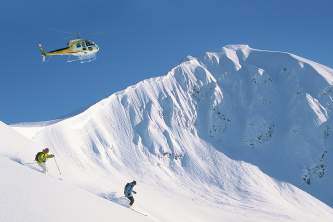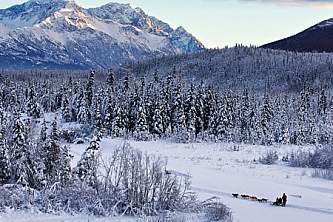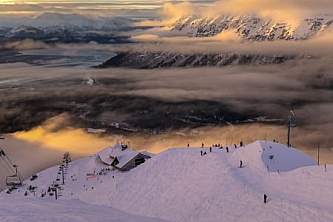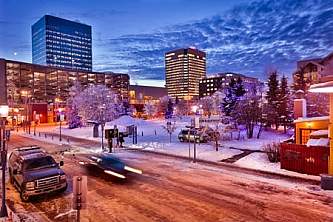The 9 Best Northern Lights Viewing Spots Near Anchorage
The Northern Lights can be seen from most places in Alaska at some point during the dark season between September and April, and there are many good viewing sites near Anchorage. But conditions must be right! Viewing a great aurora depends upon the solar activity, cloud cover, moon phase, and proximity to light pollution. Latitude is also a big factor. Most of the time, your prospects improve as you move further north, to places like Fairbanks and areas north of the Alaska Range.
But, with some luck, you can experience satisfying displays inside Alaska’s biggest city or within an hour’s drive. It’s a matter of timing, weather, and local topography.
First, check the Aurora Forecast
Because the auroral band is generated by the solar wind, scientists monitoring the sun with observatories and satellites can predict when it’s likely to become active. The Aurora Forecast sponsored by the Geophysical Institute at the University of Alaska Fairbanks has multi-day outlooks and a graphic display showing a short-term forecast that’s practically in real-time. A time-lapse version can be found at NASA’s space weather site. Here, they update twice daily, and you can even sign up for forecast updates and alerts. For aurora watchers, this forecast is indispensable.
Second, check the weather
You won’t see the aurora through thick clouds. If the solar-wind-based forecast is promising, you need to find a location with clear skies. Alaska’s classic aurora viewing occurs during cold snaps when high pressure has cleansed the atmosphere of clouds. If it’s cloudy or foggy inside Anchorage, finding wide-open skies might mean driving from sea level to a higher elevation, or driving north from town into the Matanuska-Susitna Borough. The Anchorage-area page of the National Weather Service has clickable forecasts, radar showing real-time precipitation, and satellite images of cloud cover. March and April tend to experience more clear weather than the November-to-February period.
Looking for a Tour?
If you're not ready to do it yourself, go with a local Anchorage guide to the area's hot spots.
Third, think about the moon phase
A full or half-moon can make an Alaska winter night seem as bright as day, especially with reflective snow cover. The very best aurora viewing will occur during the two weeks centered on the dark new moon. Use the Sun and Moon phase calculator from the U.S. Naval Observatory to find this period.
Fourth, stay up late
It’s a good thing that a great display can be so invigorating. In Alaska, the aurora tends to be most active between 10 pm and 2 am. The light show can amp up without warning, in just about any part of the sky, and generally remains active for at least a half-hour. If it subsides, it can return. Aurora junkies sometimes stay up most of the night.
Finally, find an unobstructed northern view away from artificial lights
The glow from streetlights and human infrastructure can rub the edge off an aurora display, transforming something dazzling and detailed into a vague milky shimmer. As a rule of thumb, you want a spot where the stars appear bright against the black dome of the sky. Or where it’s dark enough to see the Milky Way. Without trees or buildings or valley walls in the way.
Promising spots:
Show Map
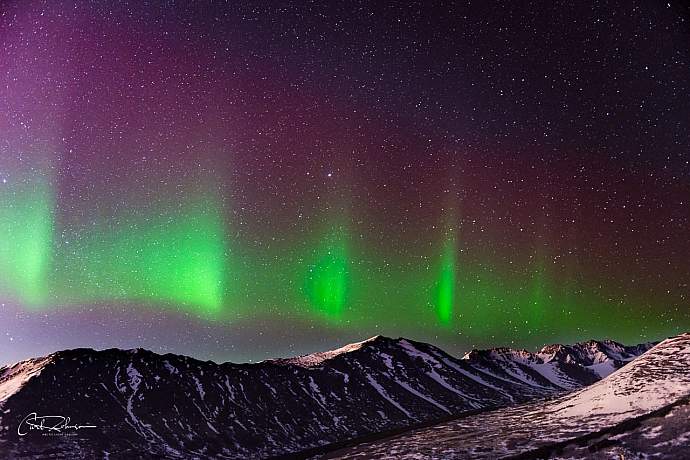
Anchorage: Glen Alps Overlook
Perched at 2,200 feet in elevation with a stunning view of the Anchorage Bowl and about five mountain ranges, the overlook at the Glen Alps trailhead into Chugach State Park may be the best place to view the aurora borealis in Anchorage. While the distant urban glow might produce some interference with clarity, the vast unobstructed view of the northern sky maximizes your chances of catching the auroral dance in action.
Getting there: Take the Seward Highway to O'Malley Road and drive toward the mountains. Follow O'Malley to Hillside Drive and turn south (right if facing mountains.) Turn left (toward the mountains) on Upper Huffman Road. About a half mile up hill, the road forks into Sultana Drive (left) and Toilsome Road (right.) Glen Alps is at the end of Toilsome Road. (Sultana leads the Upper Huffman trailhead of the park.) A $5 fee or state parking pass is required. Outhouses are open all year.
Note: Toilsome Road has a very sharp switchback and steep grades, and may require all-wheel-drive and/or good winter tires during snowy or icy conditions.
Anchorage: Downtown Viewpoint
A favorite destination for scenic shots of the Anchorage city skyline against the Chugach Front during the day, this gravel parking area off East Northern Lights Boulevard (as well as the overlook inside the nearby Earthquake Park) feature an unobstructed view of the northern sky without much immediate light pollution. The viewpoint is especially popular with guided tours.
Getting there: the Anchorage Downtown Viewpoint is off a gravel parking area just west of the intersection of Northern Lights Boulevard with Postmark Drive, about 4.2 miles west of the Seward Highway. The entrance to Earthquake Park is about .6 miles further east, about 3.5 miles west of the Seward Highway.
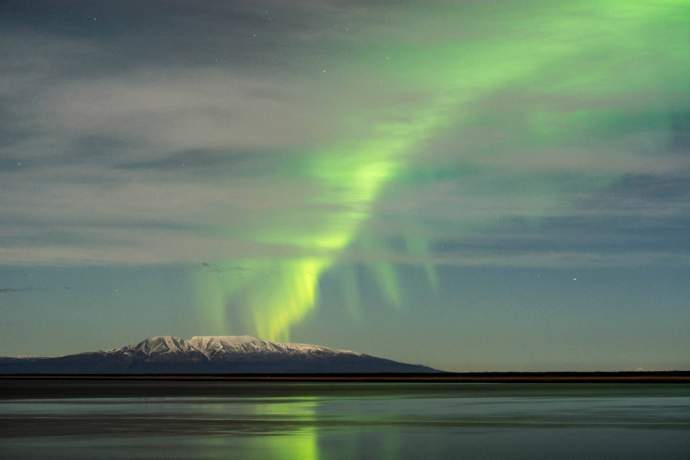
Anchorage: Point Woronzof
One of the most spectacular viewpoints in Anchorage by day, Point Woronzof perches on a northwest-facing bluff 120 feet above Knik Arm. Known for beach access and a great view of Denali, the location is wide open to the whole northern sky. This view is dark enough to allow decent aurora viewing, about four miles away from significant urban glow to the east. (Note: Just to the south sprawls the extremely well-illuminated Ted Stevens Anchorage International Airport complex. So Woronzof might not be the best place if the aurora has spread throughout the sky.)
Getting there: Take Northern Lights Boulevard west until it curves south to become Point Woronzof Road. Woronzof’s parking lot is on the right about 5.5 miles west of the Seward Highway. Walk a quarter-north on the Tony Knowles Coastal Trail to reach the highest point of the bluff with an even better view.
Eagle River: Hiland Road
Hiland Road climbs from the Eagle River Valley into an alpine zone shared by a residential neighborhood and several access points into Chugach State Park. A good place to park for Northern Lights viewing would be at the South Fork trailhead, at about 2,000 feet in elevation, with a view of the northern sky above slopes that gleam pale when shrouded in snow.
Getting there: Exit from the Glenn Highway about 10 miles north of Anchorage onto Eagle River Loop/Hiland Road and turn right almost right away on Hiland Road. About 7.5 miles up, turn right on South Creek Road and then right onto West River Drive. State parks lot is on the left. A $5 fee or annual parking pass is required. Other viewpoints may be found on the way up.
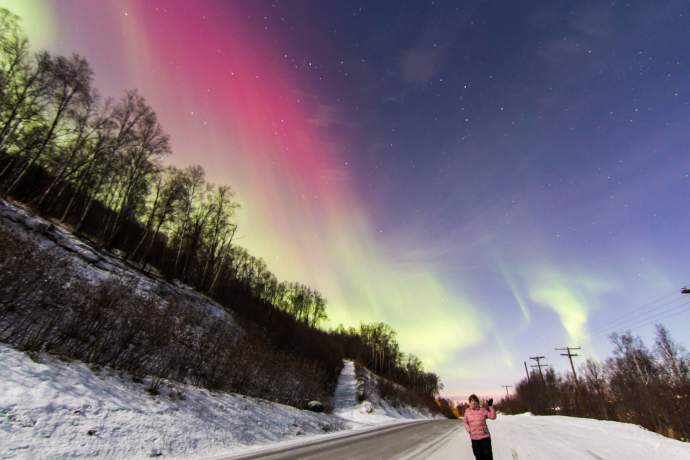
Eagle River: Skyline Drive
This curvy residential road climbs nearly 1,800 feet into the mountains overlooking Eagle River before it ends at the parking area for the popular Mount Baldy Trail in Chugach State Park. The vista is among the most spectacular in the area, rivaling the Glen Alps Overlook for its uninterrupted panorama of the northern sky.
Getting there: In Eagle River, take Eagle River Loop Road to West Skyline Drive and continue about 2.5 miles up the mountain to the trailhead. (From Anchorage, take the Glenn Highway to Eagle River Loop Road and continue across the river to the intersection, located where the Loop road begins to curve northwest.)
Note: The route traverses six switchbacks and may require all-wheel-drive and/or good winter tires during snowy or icy conditions..
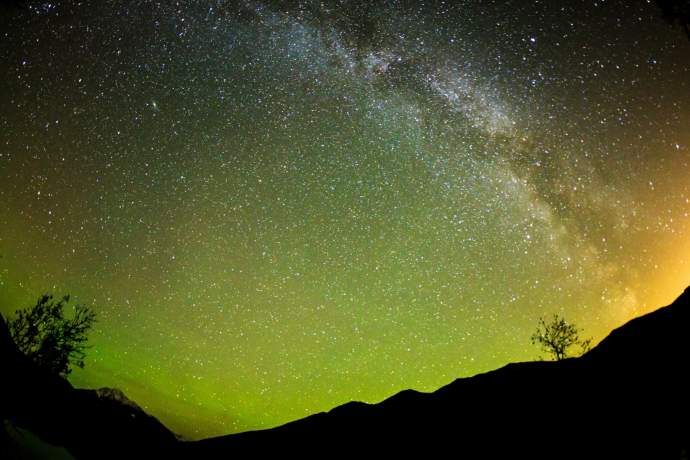
Eklutna Lake Road
The first stretch of the paved road leading to Eklutna Lake in Chugach State Park climbs about 600 feet in elevation and offers several safe places to park (and turn around) with a dark view of the northern sky. Try one of several pullouts near the entrances to the water treatment plant (about Mile 1.8) and at an overlook into the gorge (about mile 2.5.) You probably don’t want to go further at night during the winter unless you want to drive all the way to the lake (10 miles) because it can be difficult to turn around on the narrow road when it’s snowbound. If you do, make sure you have all-wheel or four-wheel drive and studded snow tires.
Getting there: Exit the Glenn Highway at Mile 26 and take Eklutna Lake Road east toward the mountains. The road ends at Eklutna Lake Campground at about Mile 10.
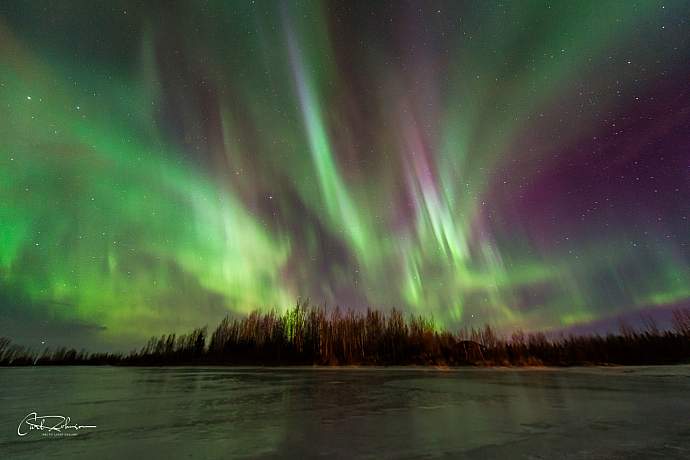
Palmer Hay Flats: Reflections Lake
This natural area with a one-mile walking loop around the lake is the easiest way to access the vast 28,800-acre Palmer Hay Flats State Game Refuge at the head of Knik Arm, where the Municipality of Anchorage meets the Matanuska Valley. What gives the site such extraordinary potential for aurora viewing is a 30-foot-high wildlife observation tower that faces west and north. (A lower level is only about nine feet off the ground.)
Getting there: Take the Knik River Access exit off the Glenn Highway at Mile 30.6 (about 32 miles from downtown Anchorage and 11 miles south of Palmer or Wasilla.) Follow the frontage road to a small parking area. The tower is on the loop trail on the northwest side of the lake.
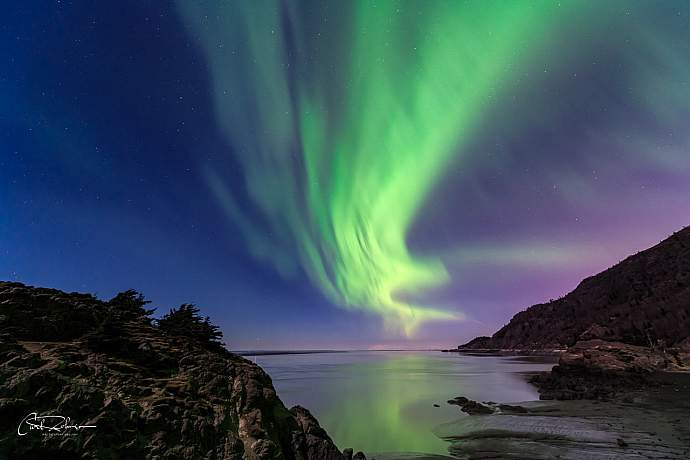
Turnagain Arm: Beluga Point
This wayside along the Seward Highway southeast of Anchorage offers a stunning view of the Kenai Mountains and the vast tidal flats of the Turnagain Arm fiord. Known as one of the best places to watch for bore tides and beluga whales during the day, the point is situated around the corner from Anchorage’s urban glow. As a result, Beluga Point can deliver a grand aurora, especially when the display has a full-sky forecast. Great photographic potential with sea, mountains and sky.
Getting there: Take the Seward Highway south past Potter Marsh along the shore of Turnagain Arm. Beluga Point is at Mile 110.4, about 18 miles south of the downtown Anchorage. Be sure to check real-time weather conditions before you go.
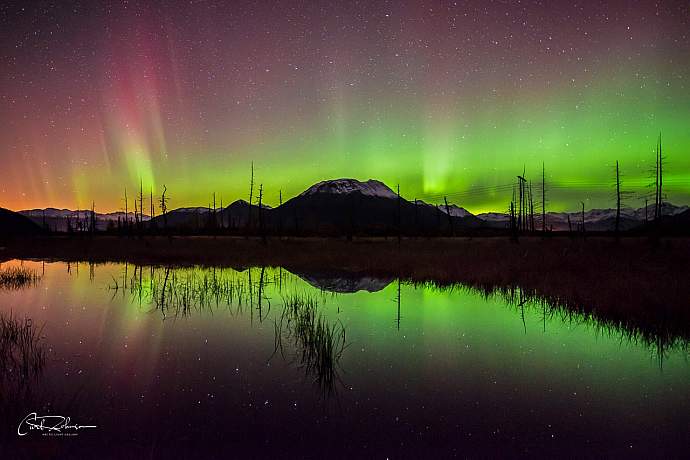
Turnagain Arm: Potter Valley to Ingram Creek, including Portage Lake
During dark, winter nights with clear weather, the head of Turnagain Arm offers surroundings that will appear otherworldly in starlight—wide river valleys, the expanse of mudflats and wetlands, the gleam of snowy mountains. Include a dancing aurora, and the setting will feel like you’ve been transported into an exotic Arctic realm. Try the parking lot on the shore of Portage Lake—where aurora bands can reflect off the ice or water—or stop at pullouts by the Placer River and Ingram Creek.
Getting there: Take the Seward Highway southeast about 45 miles to the head of Turnagain Arm. To reach Portage Lake, turn onto Portage Glacier Road at Mile 78.9 and drive 5.5 miles to the parking lot on the shore. To explore the views out in the main fiord, check out parking areas near Twentymile and Placer Rivers, and broad pullouts by Ingram Creek (about 55 miles south of Anchorage.) Be sure to check real-time weather conditions before you go.

